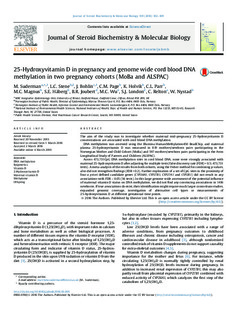| dc.contributor.author | Suderman, Matthew | |
| dc.contributor.author | Stene, Lars Christian | |
| dc.contributor.author | Bohlin, Jon | |
| dc.contributor.author | Page, Christian | |
| dc.contributor.author | Holvik, Kristin | |
| dc.contributor.author | Parr, Christine Louise | |
| dc.contributor.author | Magnus, Maria Christine | |
| dc.contributor.author | Håberg, Siri Eldevik | |
| dc.contributor.author | Joubert, Bonnie R | |
| dc.contributor.author | Wu, Michael C | |
| dc.contributor.author | London, Stephanie J | |
| dc.contributor.author | Relton, Caroline | |
| dc.contributor.author | Nystad, Wenche | |
| dc.date.accessioned | 2017-02-22T12:40:16Z | |
| dc.date.available | 2017-02-22T12:40:16Z | |
| dc.date.created | 2016-04-22T15:26:29Z | |
| dc.date.issued | 2016 | |
| dc.identifier.citation | Journal of Steroid Biochemistry and Molecular Biology. 2016, 159 102-109. | |
| dc.identifier.issn | 0960-0760 | |
| dc.identifier.uri | http://hdl.handle.net/11250/2431791 | |
| dc.description.abstract | The aim of the study was to investigate whether maternal mid-pregnancy 25-hydroxyvitamin D concentrations are associated with cord blood DNA methylation. DNA methylation was assessed using the Illumina HumanMethylation450 BeadChip, and maternal plasma 25-hydroxyvitamin D was measured in 819 mothers/newborn pairs participating in the Norwegian Mother and Child Cohort (MoBa) and 597 mothers/newborn pairs participating in the Avon Longitudinal Study of Parents and Children (ALSPAC). Across 473,731CpG DNA methylation sites in cord blood DNA, none were strongly associated with maternal 25-hydroxyvitamin D after adjusting for multiple tests (false discovery rate (FDR) > 0.5; 473,731 tests). A meta-analysis of the results from both cohorts, using the Fisher method for combining p-values, also did not strengthen findings (FDR > 0.2). Further exploration of a set of CpG sites in the proximity of four a priori defined candidate genes (CYP24A1, CYP27B1, CYP27A1 and CYP2R1) did not result in any associations with FDR < 0.05 (56 tests). In this large genome wide assessment of the potential influence of maternal vitamin D status on DNA methylation, we did not find any convincing associations in 1416 newborns. If true associations do exist, their identification might require much larger consortium studies, expanded genomic coverage, investigation of alternative cell types or measurements of 25-hydroxyvitamin D at different gestational time points. | |
| dc.language.iso | eng | |
| dc.relation.uri | http://www.sciencedirect.com/science/article/pii/S0960076016300516 | |
| dc.title | 25-Hydroxyvitamin D in pregnancy and genome wide cord blood DNA methylation in two pregnancy cohorts (MoBa and ALSPAC) | |
| dc.type | Peer reviewed | |
| dc.type | Journal article | |
| dc.source.pagenumber | 102-109 | |
| dc.source.volume | 159 | |
| dc.source.journal | Journal of Steroid Biochemistry and Molecular Biology | |
| dc.identifier.doi | 10.1016/j.jsbmb.2016.03.005 | |
| dc.identifier.cristin | 1352008 | |
| dc.relation.project | Norges forskningsråd: 221097 | |
| cristin.unitcode | 7502,3,13,0 | |
| cristin.unitcode | 7502,4,19,0 | |
| cristin.unitcode | 7502,3,8,0 | |
| cristin.unitcode | 7502,3,0,0 | |
| cristin.unitname | Barns helse | |
| cristin.unitname | Infeksjonsepidemiologi og modellering | |
| cristin.unitname | Ikke-smittsomme sykdommer | |
| cristin.unitname | Psykisk og fysisk helse | |
| cristin.ispublished | true | |
| cristin.fulltext | original | |
| cristin.qualitycode | 1 | |
